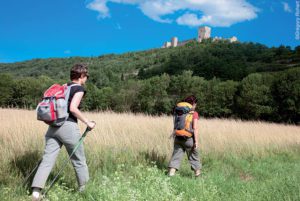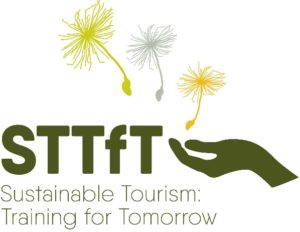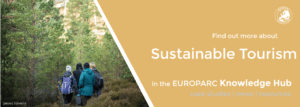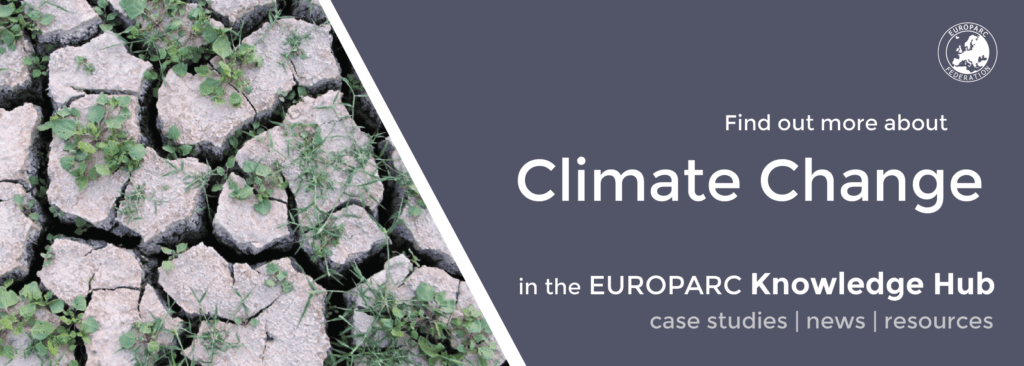Workshop outcomes: Are we ready for ecotourism?
Photo: Delta Polet
During the ONLINE Conference 2020, EUROPARC held 8 thematic workshops to discuss diverse topics related to practice and capacity building in Protected Areas (PAs). In case you have not attended, or want to remind yourself of their outcomes, a series of articles summarises the content of some of these workshops.
Facing the new reality for tourism
In the Conference Workshop on “Sustainable Tourism: are we ready for ecotourism as the new future?” we talked about how the end of coronavirus lockdown created a rush to parks and green spaces to celebrate the end of confinement. People recognised that Protected Areas provide an added value, important for their health and wellbeing.
We also analysed the new visitors profiles, mostly domestic visitors, that the new reality has brought to parks this summer. We discussed on what new capacities and activities would the parks need to build on in order to provide these newcomers with the best-quality services and, at the same time, safe experiences.

Photo: Sud Randos, ©Gregory Rohart
Concisely, these practical capacity building requirements of PAs and staff/organisational competencies will need to be developed to adapt to the new situation:
- Creative and innovative thinking, not only for visitor centres but also for managers. We might encounter new crisis and we need to think differently to deal with them.
- Social abilities: ability to meet and understand people and to avoid and solve potential conflict situations.
- Visitor knowledge and monitoring: need to know the visitors better, understand their behaviour, their needs and how to reach them – especially new audiences such as domestic visitors, who are different from tourists (they are more families’ type) and use different channels of communication.
- Services design thinking: in order to offer more sustainable services. It is important to know the “visitor’s path”: before, during and after the visit to the PA, in order to guarantee sustainability.
- Visitor management plans for large numbers: How to manage large numbers of people (parking lots crowded, excess of people in sensitive areas, etc.)? Need to apply new approaches.
- Effective communication. How to influence the behaviour of visitors effectively? How to deal with new audiences? How to make the most of this opportunity for encouraging new visitors)? Use of IT for real time info /communication contents.
- Partnership working. How to establish partnerships with stakeholders, touristic enterprises, etc.?
Furthermore, we heard two inspiring examples of how parks and sustainable tourism entities are actively adapting to the new situation by offering new services, with more creativity, and new ways of working.
Download the presentations
1: Cairngorms National Park (Scotland): Re-starting the visitor economy in the in the strangest season ever. #CairngormsTogether by Murray Ferguson.
2: Trentino Natura Sicura: how Trentino’s protected areas reshaped their offer in summer 2020 by Antonella Faoro.
For more information, please do not hesitate to contact Teresa Pastor, Project Development & Charter Sustainable Tourism Manager at EUROPARC Federation.
The Council of EU on the Farm to Fork strategy
Photo by Jan Kopřiva on Unsplash
The Council prioritises actions for sustainable food systems, find below the conclusions on the Farm to Fork strategy.
On 19th of October 2020, the Council of the European Union adopted a set of conclusions on the Farm to Fork strategy, endorsing the goal of developing a European sustainable food system, from production to consumption. The conclusions entail a two-fold political message from the member states:
- Ensure sufficient and affordable food while contributing to EU climate neutrality by 2050
- Ensure a fair income and strong support for primary producers.
The unanimous decision reached is a crucial signal and a clear commitment to a sustainable and economically viable agri-food sector. For the first time, the entire food system is taken into account as a whole – from producers to consumers. It is a solid starting point and we are looking forward to working altogether the coming years towards a truly sustainable and fair food system in Europe and beyond.
Says Julia Klöckner, Federal Minister for Food and Agriculture of Germany.
In the conclusions, member states recognise that European food is already a global standard for safety, nutritional value and high quality and, thus, they recognise the importance of promoting sustainability of food systems at a global level.
Comments from Member States
Some positive declarations from Member States can be reported. The importance of supporting local food systems was mentioned by several members, like Slovakia and Croatia. Croatia also mentioned the need to protect the diversity of genetic resources to protect agro-biodiversity. Malta welcomed the text concerning the Fisheries sector. Luxembourg and Finland welcomed the revision of the animal welfare regulation. France said that it will be crucial to arrive to consensus in European legislation in areas like pesticides. France, Spain called for consistency across different policies, like Trade. Spain, Luxembourg and others said that trade agreements with Not-EU countries should set up equitable rules for European producers and those outside EU too.
On labeling, Italy said that nutritional labeling is very sensitive, and more efforts are needed in raising awareness about balanced diets, but not to classify food as good or bad (although they also said that they are in favour of transparent information for consumers). Cyprus found labeling important for healthy and safe diets, so consumers can take reasoned decisions to look at the properties of the products. Spain also mentioned to be in favour of promoting responsible consumption.
However, the ministers express some cautions
The Council calls for scientifically-sound ex-ante impact assessments that have to be the basis of EU legislative proposals under the Farm to Fork strategy. About pesticides, antimicrobials and fertilisers, it asks to continue promoting the prudent and responsible use of in order to produce food sustainably and support the environment at the same time, despite the requests from the environmental sector to reduce drastically or completely quit their use. Finally, ministers call for a level playing field on competitive agri-food markets and compatibility with WTO rules, especially concerned about the competition with non-EU countries. A general request to the Commission is to proceed with impact assessments to evaluate possible major impacts in food security in the EU.
This compromised position can be considered a positive achievement of the German Presidency of the Council.
Nevertheless the main issue remains the coherence with the Common Agriculture Policy. Farm to Fork’s objectives and aspirational targets are, until now, not legally binding. Therefore they can be considered – the Council stressed – only just recommendations for the CAP National Strategic Plans that the Member States will need to prepare in the framework of the new CAP. To reinforce this point, the Member States called for higher flexibility to prepare their CAP strategic plans.
The same week, the Council, voting on the CAP, diluted the environmental and social ambition from 2018 Commission proposal, making it not in line with the European Green Deal, Farm to Fork and Biodiversity Strategies. In response, EUROPARC together with 26 other NGO’s wrote an open letter to President Ursula Von der Leyen urging the Withdrawal of the Commission proposal for the post-2020 Common Agricultural Policy
More:
Council Conclusions on the Farm to Fork Strategy, as approved by the Agriculture and Fisheries Council on 19 October 2020 can be found here.
The video of the debate can be found here.
[WEBINAR] Sustainable Tourism – Training for Tomorrow
This webinar on the 23rd of November at 14:00 CET will look at the new online tool to help learning about Sustainable Tourism in Protected Areas.
In this webinar, we’ll introduce an inspiring online learning platform, filled with key information on topics such as effective visitor communication, monitoring, conservation through tourism, reducing impacts and much more. It includes interesting European case studies, follow up resources and quizzes. The platform is targeted at anyone with an interest in sustainable tourism in Protected Areas.
Sign up here

Agenda
Welcome
by Carol Ritchie, EUROPARC Federation
Guided tour on the platform
by Elke Hermans, Hasselt University, coordinator of the Erasmus+ STTfT project
Introduction of the platform containing new and inspiring material on sustainable tourism for protected area stakeholders
Testimonial of a platform user
by Sara Zappini, Terme di Rabbi (IT)
Case studies on Sustainable Tourism in Protected Areas
-
- Gomera Experience: an inspiring tool to promote ecotourism for businesses in La Gomera (Spain)
By Manuel Fernando Martín, Sustainable Tourism Association of La Gomera - Conservation through tourism – Mobilisation of volunteers for the creation and rehabilitation of mountain bike circuits
By Olaf Holm, Parc naturel regional de la Montagne de Reims
- Gomera Experience: an inspiring tool to promote ecotourism for businesses in La Gomera (Spain)
Let’s talk about it
All participants have the opportunity to exchange on the topics discusses and/or to ask questions.
Announcement “Train the Trainer” Event
Upcoming in 2021: an offer for potential trainers on Sustainable Tourism development in Protected Areas.
Get to know the speakers!
Carol Ritchie is the Executive Director of the EUROPARC Federation. She is responsible for the smooth running of all the Federation Directorate and its work. Carol operates across Europe to represent the Federation’s interest and to support the work of the President and Council.
Elke Hermans is professor in tourism and transport at Hasselt University in Belgium. Her teaching and research activities focus on sustainable tourism and transport. She is the coordinator of the Erasmus+ “Sustainable Tourism: Training for Tomorrow” project.
Sara Zappini is the Director of Terme di Rabbi, a thermal and wellness spa in the Stelvio National Park. Health, wellness and nature are her landmarks in managing the Thermae in the Rabbi Valley, which lays at the heart of the National Park.
Manuel Fernando Martín is the Vice president of the Sustainable Tourism Association of La Gomera, which collaborates with the Garajonay National Park and is committed to promoting sustainable tourism on the island.
Olaf Holm is the director of Parc naturel regional de la Montagne de Reims in France. The Park’s missions is to aim to protect and enhance its unique landscapes, natural and cultural heritage. Additionally, Olaf is a member of the EUROPARC council.
Sign up here
This webinar is powered by

Time to restore nature – but where?
Collserola nature park Oak Forest - Autor Robert Peña
A new study published in the magazine “Nature” highlights that restoring nature, is a low-cost and highly effective method to store carbon and battle biodiversity loss. However it strongly depends on how and where it is done.
To mitigate the climate crisis, carbon storage will be of great importance. Trees are experts at this so called “carbon sequestration”, which is partly the reason why the new EU Green Deal calls for 3 billion trees to be planted in the upcoming 10 years.
However, actively planting new trees is not the only solution. A new study by Bernando B.N. Strassburg et. al. shows that rewilding is a highly effective method to combat biodiversity loss AND store carbon. The study, published in the magazine “Nature” found that:
restoring 15% of converted lands in priority areas could avoid 60% of expected extinctions while sequestering 299 gigatonnes of CO2 — 30% of the total CO2 increase in the atmosphere since the Industrial Revolution.
The research looked at where this nature restoration would be most effective – and what the costs are. Currently, only 1% of finances devoted to combat climate change globally are put towards restoring nature, however the research found that it is one of the most cost effective methods to absorb and store carbon dioxide from the atmosphere, with wildlife protection being an additional benefit.
The “how and where”
The costs and benefits of nature restoration greatly depend on where AND how it is done. Planting trees in itself may be a great idea to mitigate climate change, however planting trees in areas that were previously not forested can have adverse effects on biodiversity levels in that area.
To yield the best results, the study found that it is important to take a multi-benefit approach. This means that when a natural area is restored with only one benefit in mind – for example carbon sequestration – it will not yield the best results for biodiversity conservation and restoration. Researchers encouraged that restoration should be done with three criteria in mind: climate change mitigation, biodiversity benefits, and costs:
Optimising for all three criteria simultaneously yields a solution that would achieve 91% and 82% of potential gains for biodiversity and climate-change mitigation respectively, while maximising cost-effectiveness.
This study is further evidence that the answer also lies in nature, something Protected Areas have long known. Protected Areas are central to protect and restore nature in an effective way.
At the EUROPARC Federation, we are glad that the new Biodiversity Strategy recognizes their importance, it is now time to adequately put the strategy into practice.
Sources:
Article: Prioritizing where to restore Earth’s ecosystems, Nature Magazine

